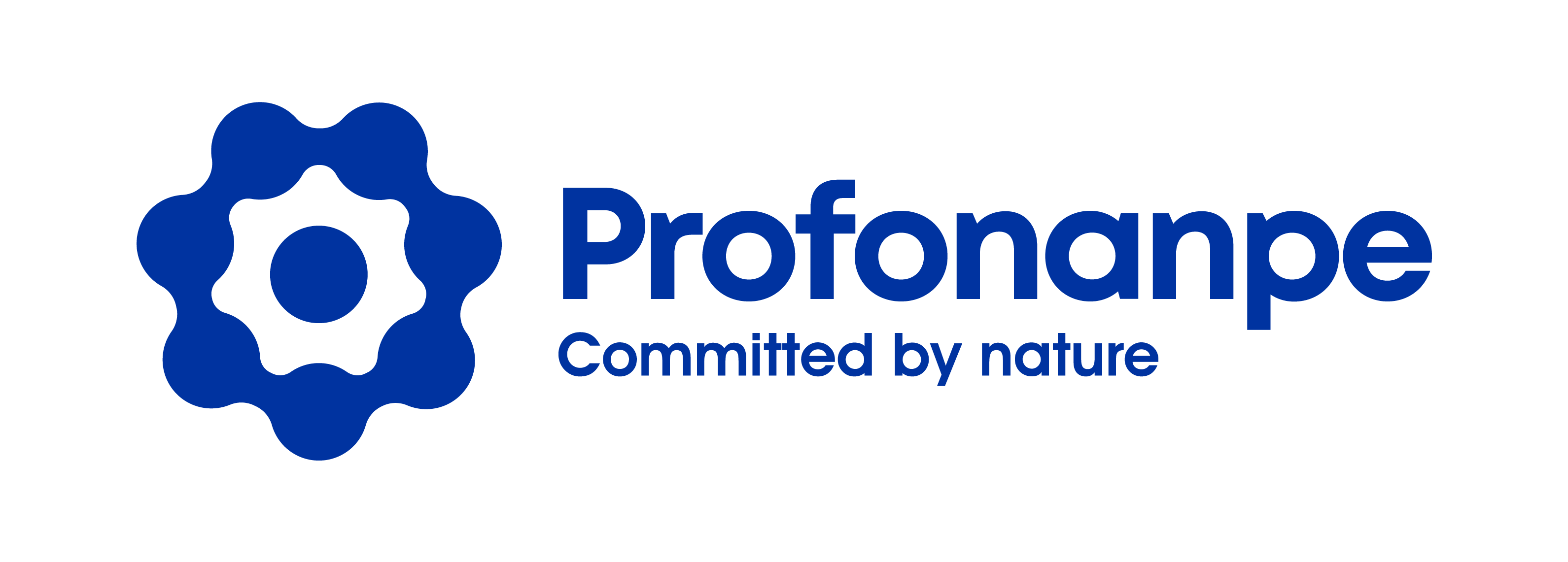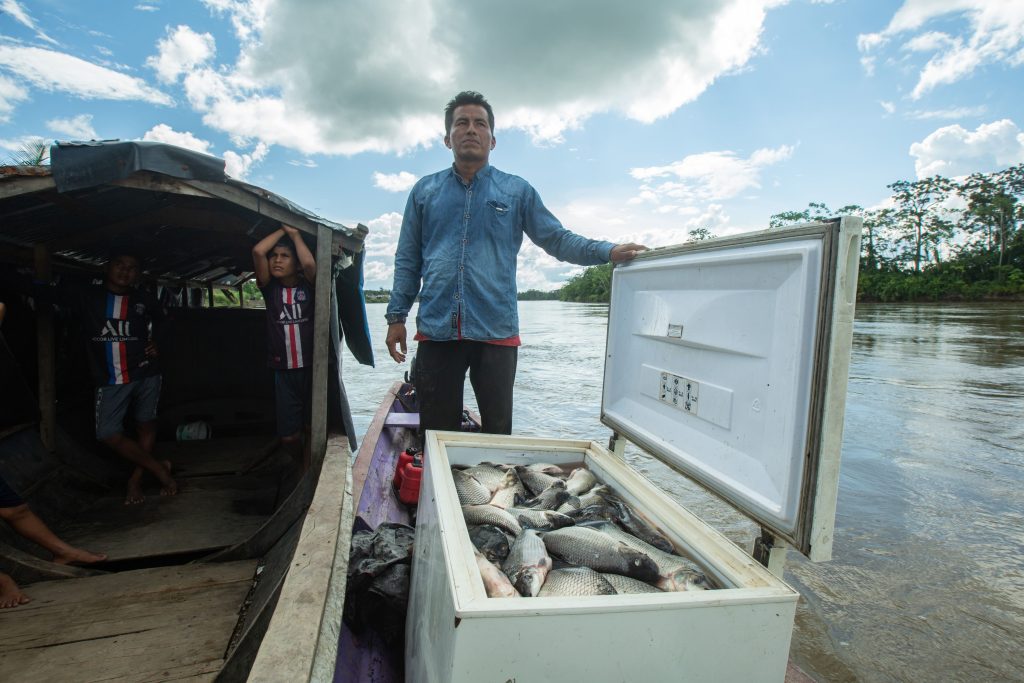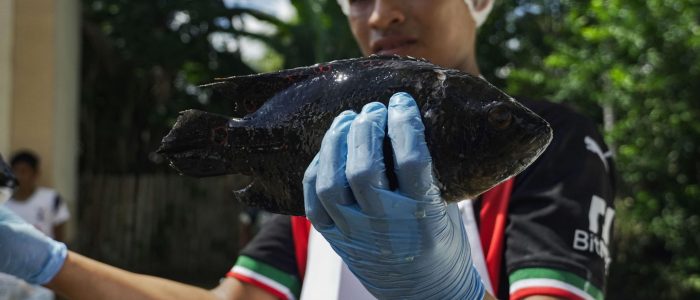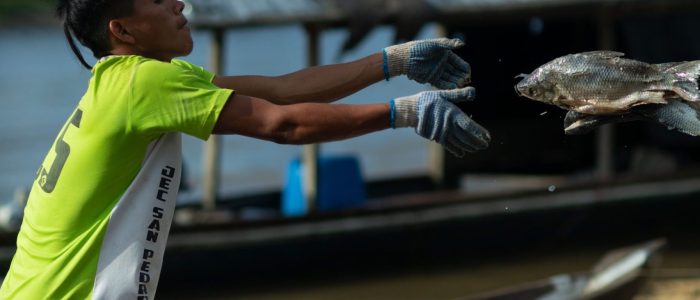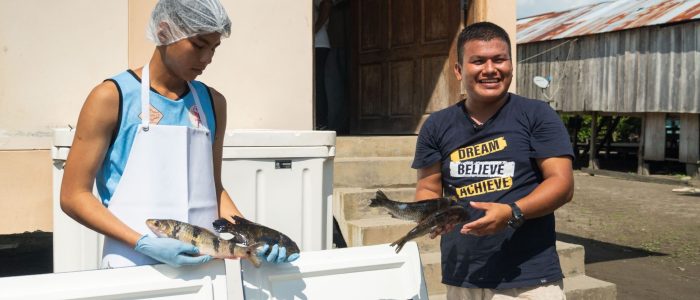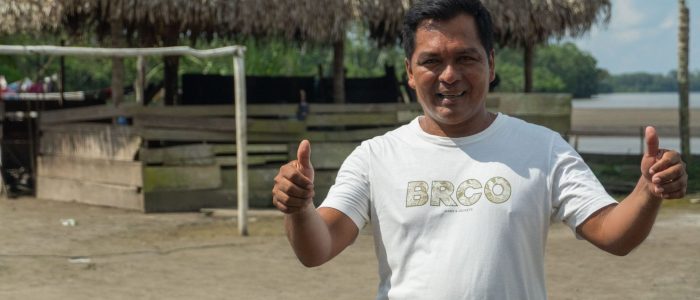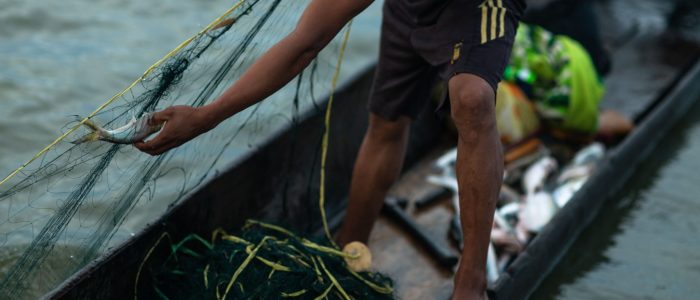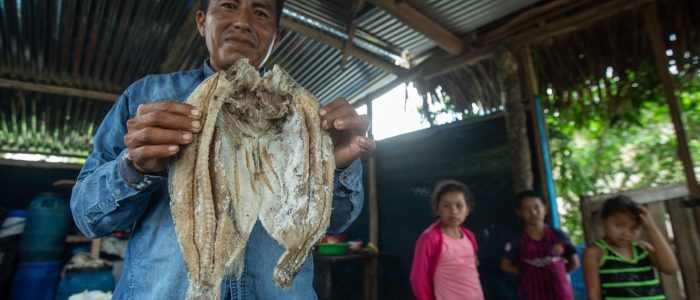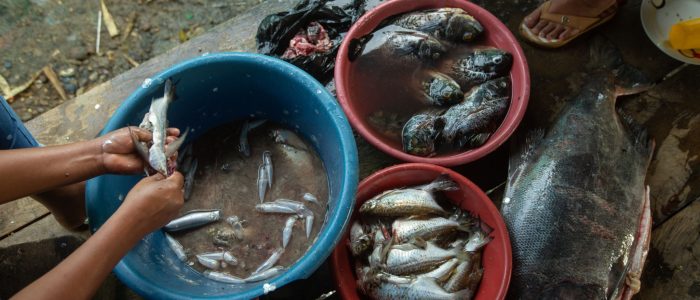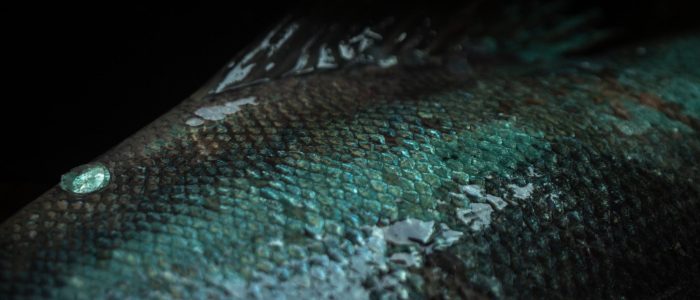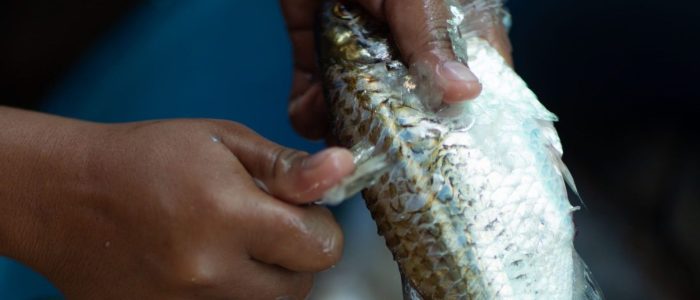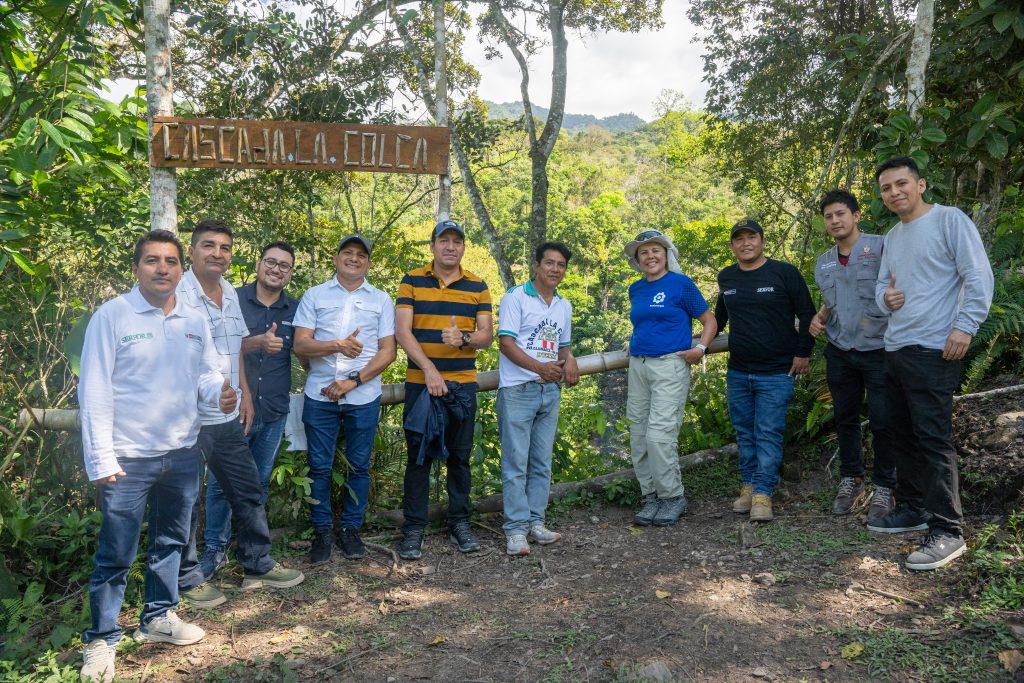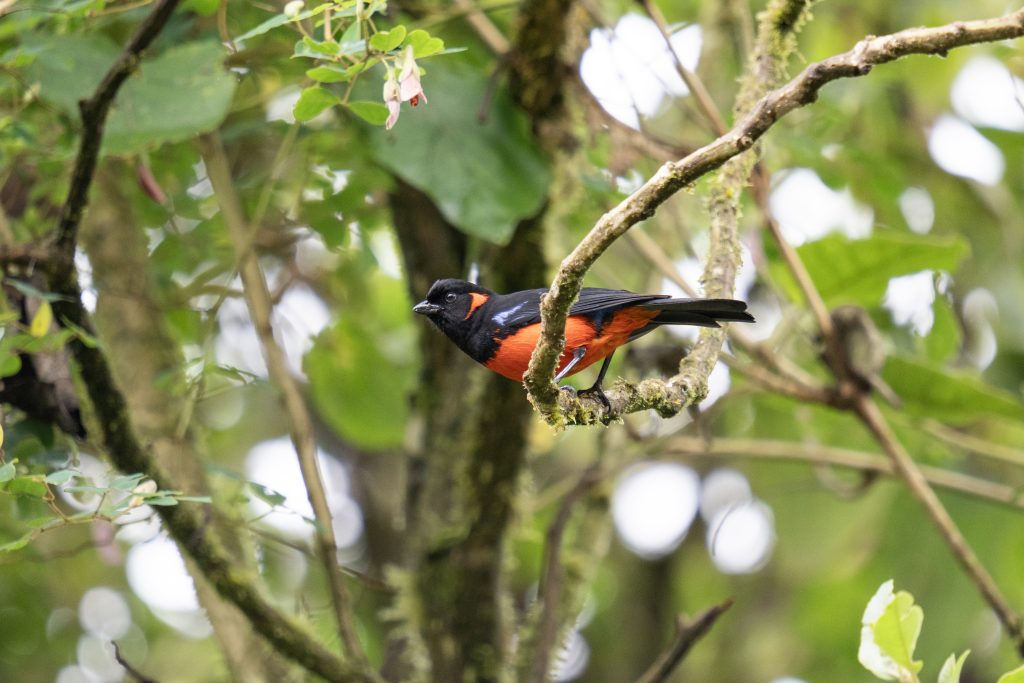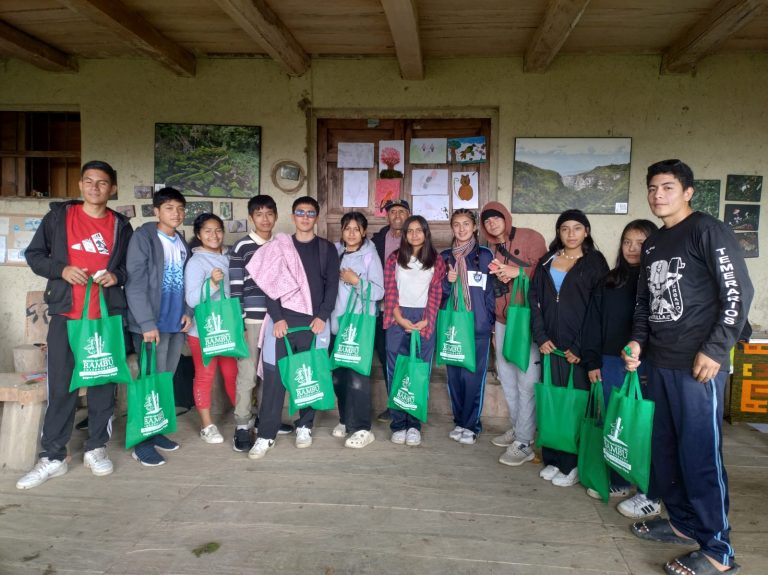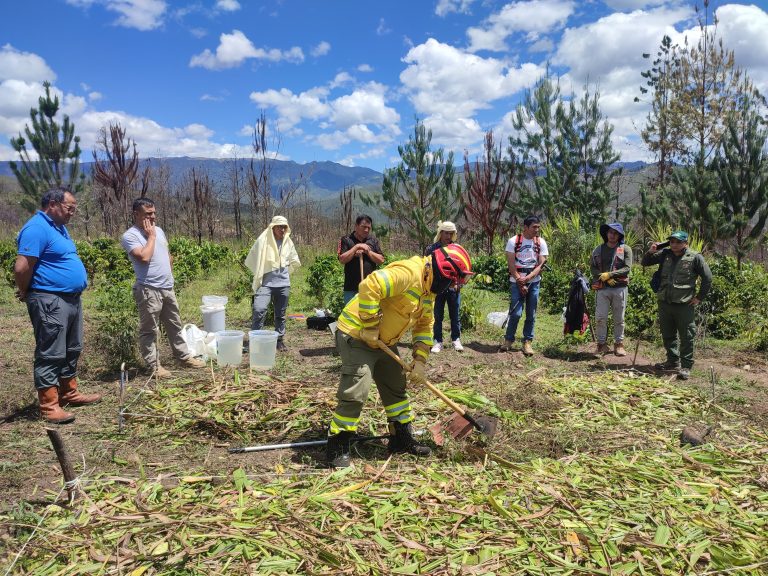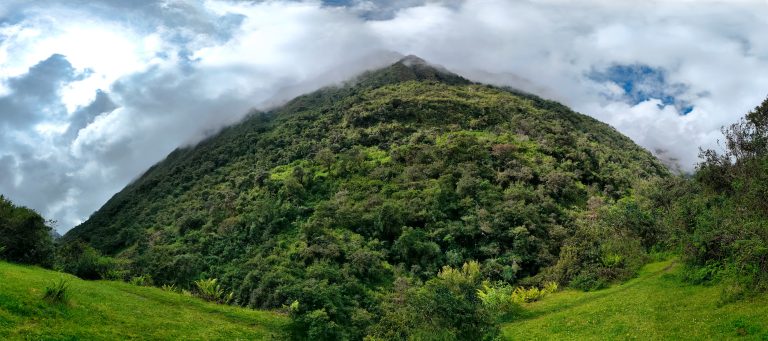Gunter Yandari remembered spending time in the oxbow lakes of the Pirumba river basin learning how to fish with his father. He grew up learning how to set up fishing stations and look for schools of boquichicos by circling the lagoons. Like most of the people in his neighbourhood, fishing became his trade. Or much more than that: Gunter’s story was a continuation of his people’s way of life, the Kandozi, whose whole nature is closely linked to water and the creatures that live there. They even give seasonal streams and oxbow lakes their own names since water supplies are so vital to them. Because fishing is such an important subsistence activity, fish species names have historically been given to the men.
Gunter is now president of the Katinbaschi fishermen’s association, which brings together 120 indigenous fishermen from 20 native communities. He is a middle-aged man of discreet manners. In partnership with the Building the Resilience of Wetlands in Datem del Marañón project, Katinbaschi extracts about 500,000 kilos per season and runs an ice plant in the Musa Karusha Native Community.
The association’s fishing area is the Musa Karusha oxbow lake system, which consists of Lake Rimachi, the largest lake in the Peruvian Amazon, and a group of 40 interconnected smaller lakes. The System is the product of blocked valleys in the Pastaza basin generated by the accumulation of sediments, a space without equal in the Amazon: because the Pastaza is located in the equatorial convergence zone, it is influenced by the hydrology of both the northern and southern hemispheres. For this reason, it experiences two periods of flooding, corresponding to the rainy season in each hemisphere.
This region has been home to the Kandozi for hundreds, if not thousands of years. Fishing has been the primary means of livelihood here, since the boundaries between land and sea are blurred. On the other hand, the Kandozi experienced limitations on their access to vast quantities of water or faced disadvantages in the fish selling chain throughout the latter part of the 20th century. These days, this is progressively changing because to associations like Katinbaschi.
A fishing village
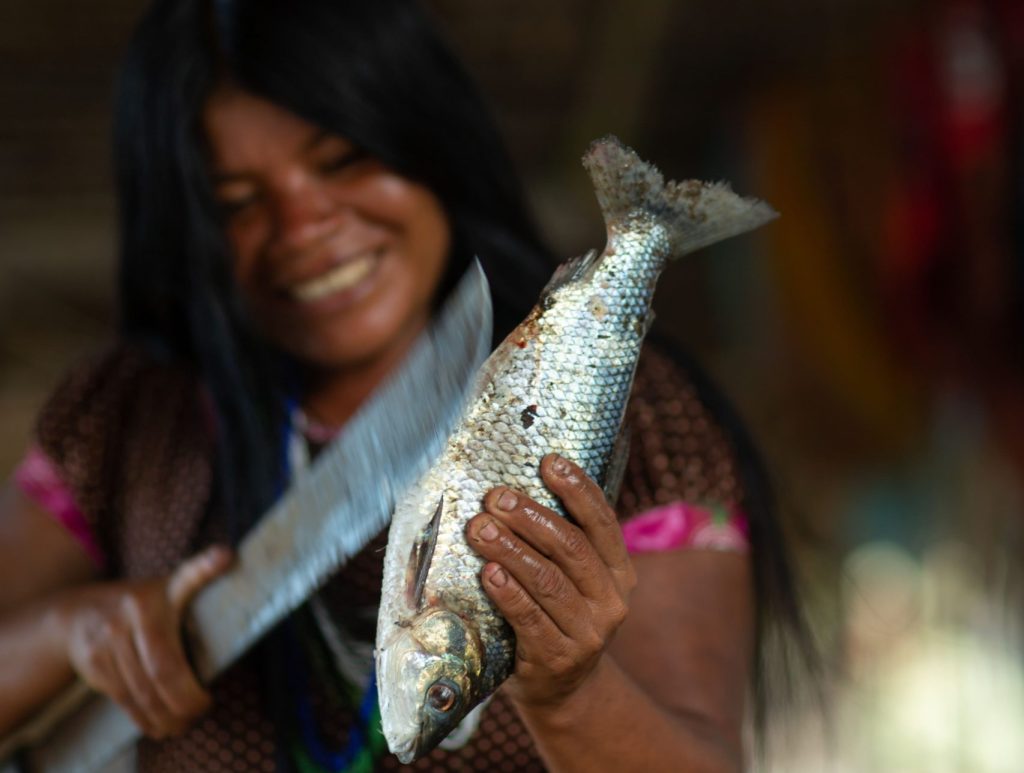
Indigenous knowledge systems are closely tied to the region’s ecosystem, and fishing and other subsistence activities, including farming and hunting, are part of this knowledge system. The huge fish leave the ‘aguajales’ during the dry season, or ‘mijano’, and migrate to the oxbow lakes, where they are easier to catch, according to the Kandozi fisherman. The best times to catch the species are known to the Kandozi, who are familiar with their migration paths. Knowledge of the hydrobiological cycles and the ancestral practices associated with them have been passed down from generation to generation, through the Kandozi-Chapra language, a unique linguistic family in Peru.
In the past, the region around Lake Rimachi was home to the Kandozi. They were «reduced» by the Jesuit order in the 18th century at the Bajo Huasaga mission Nuestra Señora de los Dolores de Muratas. They were referred to as «muratos» until the end of the 20th century because of this. They refer to themselves as «we and beings like us» (kandozi), an autonym that sets them apart from other human groups like the Wampís and the Kichwas. They also belong to plant and animal species that are classified as human. As of right now, an estimated 4847 persons reside in Kandozi villages, and 1597 self-identify as such based on their ancestors and customs, according to the Ministry of Culture’s Indigenous Peoples Database.
From generation to generation, the Kandozi have been fishermen. The most significant ritual activity that has historically been associated with fishing is the employment of incantations, which are also employed in hunting and harvesting. These incantations are made up of private, silent recitations of litanies. While the males study the incantations of the hunting animals, the ladies are taught chants related to the species in the garden. When it comes to fishing, each kind of fish has its own song, but the chants are distinct based on how the fish are caught. For this reason, fishing has a religious element for the Kandozi, as does the area where it occurs. Their genesis story states that the mainland, called tsaponish, emerged from Lake Rimachi (Musa Karusha in Kandozi) and can disappear underwater at any time. This sacred place, however, was restricted to the Kandozi for decades, until its «reclamation» in the 1990s.
The battle for Musa Karusha
Early in the 1940s, there was a conflict between Ecuador and Peru. The government placed great emphasis on the Amazon as a result of the conflict, particularly the northern regions where the battle was fought. Abruptly, the Peruvian state placed a premium on the then-province of Alto Amazonas. Without consulting the Kandozi, Manuel Prado’s administration decided in 1945 to turn Lake Rimachi into a fishing reserve for the major Amazonian fish species, especially the gamitana (Colossoma macropomum) and paiche (Arapaima gigas), in order to capitalise on strategic resources. This meant, at least in formal terms, that the lake was a fishing-free zone. The government installed a control post that operated on a discretionary basis until the Armed Forces took over during the military dictatorship of Juan Velasco Alvarado and Francisco Morales Bermudez.
The government opened up fishing in the region to any boat in the 1980s, but only mestizo fishermen who spoke Spanish were able to apply for permits. The majority of Kandozi at the time were monolingual and had a low level of formal education, a public service that is still deficient in their communities. Because of this regulation, outside vessels were allowed to enter Lake Rimachi but the Kandozi were not allowed to. The exclusion of the Kandozi people led to overexploitation of fishery resources and enormous social discontent. Both their primary fish supply source and the most significant holy location in their spiritual hierarchy had been cut off by the government. A protest was sparked by this circumstance in 1991: the Kandozi communities seized the Ministry of Fisheries checkpoint and prevented all commercial fishing vessels from accessing the Rimachi. The blockade lasted for nearly two years.
The impasse that existed between the State and the Kandozi was only broken in 1993, owing to the direct intervention of the then-President of the Republic, who had a fondness for fishing in the Amazon. An agreement for the management and community monitoring of the reserved zone was developed by the Loreto Regional Directorate of Fisheries, which acknowledged «the presence and rights of the Kandosi and Jíbaro native communities settled within the Reserved Zone of the Pastaza River». This arrangement allowed the Kandozi people to take effective control of the lake and started the process of reintroducing their species. The Kandozi, however, were still dependent on mestizo middlemen who were now the resource purchasers despite their advancement. Under this job plan, the mestizos purchased the product and sold it in the neighbourhood markets, while the kandozi were in charge of fishing and processing the fish, pishtarlo (gutting it) and salting it.
In these circumstances, the indigenous fishermen acquired inputs such as motors, nets and salt from the traders, who gave these items in advance. The Kandozi acquired debts and had to intensify fishing in order to pay back the mestizo traders. Gunter recalls that at this time, around the mid-1990s, the Kandozi’s trading options were limited, which affected the price of the product:
«In the past, we were dependent on other dealers who borrowed money and occasionally made payments or not at all. It used to be the way we worked. We had to sell cheaply back then since there were no local dealers, only mestizos, and they only paid 50 cents per kilogramme or 1 sol. We thought that two soles per kilogramme was excessive, as it was at that time.»
On the other hand, new fishing technology were introduced to the Kandozi. The extraction capability of modern equipment like motorised vessels and synthetic nets was higher than that of traditional and ritualised approaches. The overfishing that has occurred is also a result of this technical advancement. Additionally, fish were salted for selling owing to challenges with preservation. This technique was brought to the Amazon hundreds of years ago by evangelistic missionaries. Fish that has been salted can be kept for up to a month without refrigeration, but the process significantly changes the product’s nutritional value by adding a lot of sodium and changing the ratio of fatty acids.
In addition, primary producers do not gain from fish. Meat shrinks as it is dehydrated, lowering the product’s weight. But the Kandozi had nowhere else to go when it came to cold storage and ice. Gunter turns to me and says, «What do we have to do?» remembering the circumstances. «We were forced to choose between pishtar and salting the fish, but we lost the kilogrammes of it. We couldn’t, but those who had refrigerators and ice could. The business circumstances for selling the fish eventually promoted overfishing to make up for the weight lost during the conversion process, despite the attempts to refill the lake basin that started following its recovery. This predicament persisted for almost ten years.
Making trade fairer
The changes began in the mid-2000s. With the support of non-profit organisations, the Kandozi organised themselves into artisanal fishermen’s associations in order to process management plans. Between 2004 and 2006, the Kandozi managed their first formal fishing authorisations. Katinbaschi in the Pastaza district, of which Gunter is president, and Kachizpani in the Andoas district were among the associations created at this time. Today, Kachizpani brings together more than 100 Kandozi fishermen from 7 native communities, whose fishing grounds are located in the oxbow lake system of the Huitoyacu basin, located on the right bank of the Pastaza River.
Profonanpe has highlighted the efforts started by non-profit groups and the Kandozi people through the Building the Resilience of Wetlands in Datem del Marañón project. The use of clean technology to alter the commercialization strategies used in the last several decades and the provision of training focused on the sustainability of fishing resources are the main components of the intervention. For instance, fisherman using Kandozi nets are aware of the required mesh sizes to prevent capturing fish of the wrong size. They currently utilise nets that have stretched mesh apertures of at least 3.5 inches, as specified in their instruments for productive management.
In an effort to alter the fishing industry, Profonanpe started researching the building of photovoltaic-powered ice facilities in 2019. This would enable locals to sell fresh fish and reduce the need for intermediaries. Gunter claims that the Musa Karusha fishermen themselves requested the ice plant since they had begun selling fresh fish in small amounts. The plan was to sell directly to wholesalers in Tarapoto, Yurimaguas, and San Lorenzo, or via outside collectors who would pay a reasonable price. In order to ensure its long-term conservation, this would enable the reduction of the loss and the establishment of more suitable resource management standards. Additionally, by excluding the expenses related to the usage of salt, the fisherman of Kandozi may increase their profits without the need to overexploit their oxbow lakes and lagoons.
At the moment, the ice plants at Musa Karusha and San Fernando are managed by Katinbaschi and Kachizpani, respectively. The cession of land by the communities for the solar panels that power these industries allowed for their construction. The Kachizpani president, Rider Gais, claims that fishing has become a means of «teaching the indigenous brothers and sisters that business can be done differently» because of the ice industry. To be more precise, the plants serve two main purposes. To prepare the river water for industrial usage and purification, they first treat it. Stated differently, it is transformed into potable water. Secondly, solid blocks of ice are created by compressing the treated water into moulds and freezing them. The first quarter of 2021 saw the start of operations for these and they have continued to supply ice to both associations.
At present, the ice plants have the capacity to produce 500 ice bars per month. In the first year of operation (2021-2022), the Katinbaschi plant produced 3700 bars and the Kachizpani plant 2500. Both associations utilise them for selling fish to outside collectors who purchase fish locally, or for transporting fish to metropolitan markets. Thus, the sale of ice functions as a potentially lucrative industry in and of itself. A bar can be produced for less than three soles, and it sells for ten to twelve soles, which is significantly less than the value of ice offered in cities like Yurimaguas, where it can cost up to twice as much and is of lower quality, typically cloudy, yellowish in colour, and not very durable. After being refrigerated, vessels equipped with isothermal box carriers deliver the fish to the markets.
The total catch between Kachizpani and Katinbaschi for the 2021–2022 fishing season is 648,790 kg. In both associations, most of the catch is for the production of salted fish, but this has been changing since the operation of the ice plants. Thanks to the availability of ice blocks, fishermen are less dependent on salt and the volume of fish caught is not reduced. In addition to the physical enhancement of areas designated for fish processing, this procedure has been supported by training designed to uphold minimum sizes and respect fishing windows. Evisceration and filleting are particularly crucial since they reduce waste and increase the profitability of the product’s sale when done correctly. With these newly acquired advantages, the kandozi are claiming their place in the regional market.
Adapting to global warming
Both Gunter and Rider remember having no trouble using spearguns when fishing for paiches and tucunares as teens, with their parents providing guidance. Rising temperatures and lagoon sedimentation are affecting the Pastaza Fan and the oxbow lake systems that comprise the centre region of the Kandozi homeland. The Pastaza River’s natural migration has caused sedimentation in Lake Rimachi, but there may be other factors at play as well, like the imbalance brought on by decades of overfishing and the vanishing of biological controllers like manatees (Trichechus inunguis). The province of Datem del Marañón may have longer summers and less frequent flooding as a result of global warming.
The Datem del Marañon indigenous fisherman groups play a pivotal role in maintaining the fish population at sufficient levels for their sustainable reproduction. This is a climate change adaptation activity that also helps to mitigate the effects of climate change by preserving the carbon reserves found in the Abanico del Pastaza turberas. More equal access to resources has been made possible by the preservation of indigenous peoples’ territorial rights, the use of modern technologies, and the development of communication skills with government agencies. Additionally, unfavourable fishing and processing methods from the past have been reversed. Ironically, a substance as foreign to the Amazon as ice is assisting in the preservation of its riches in one of its warmest regions on the planet. The cold of the ice is empowering the kandozi.
Bibliography
Montoya, M. (2010). How Access, Values, and History shape the Sustainability of a Social- Ecological System: The Case of the Kandozi Indigenous Group of Peru. [Tesis doctoral]. University of Texas. https://repositories.lib.utexas.edu/handle/2152/ETD-UT-2010-12-2166
Surrallés, A. (2009). En el corazón del sentido. Percepción, afectividad, acción en los Candoshi, Alta Amazonía. IFEA.

